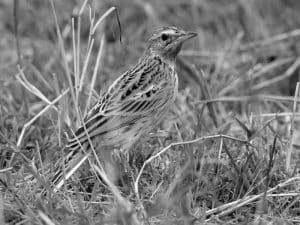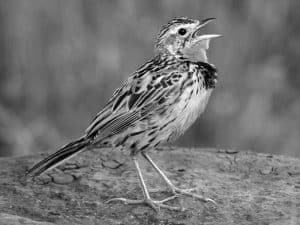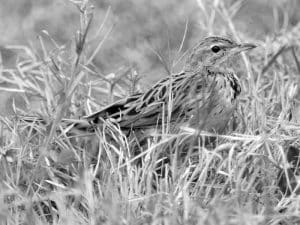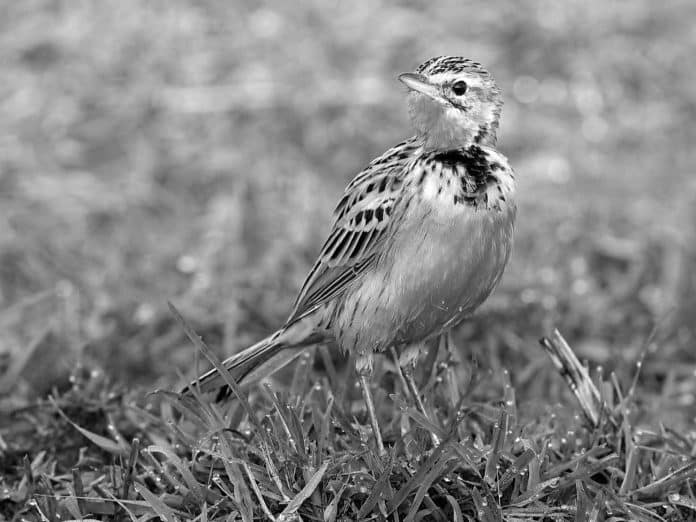Introduction to the Rosy-Throated Longclaw
Nestled within the vast and diverse landscapes of Tanzania lies a true avian gem – the captivating Rosy-Throated Longclaw. This stunning bird, with its vibrant plumage and mesmerizing behavior, has long captured the attention of birdwatchers and nature enthusiasts from around the world. As you embark on your journey through the enchanting wilderness, prepare to be enchanted by the Rosy-Throated Longclaw in Tanzania, a species that will leave an indelible mark on your heart and memory.

In this comprehensive guide, we will delve into the fascinating world of the Rosy-Throated Longclaw, exploring its habitat, physical characteristics, and the best places to spot this remarkable bird. Whether you’re a seasoned birdwatcher or a nature lover seeking a new adventure, this article will equip you with the knowledge and insights to make the most of your Tanzanian birdwatching experience.
Habitat and Distribution of the Rosy-Throated Longclaw in Tanzania
The Rosy-Throated Longclaw, scientifically known as Macronyx ameliae, is a stunning avian species that calls the diverse landscapes of Tanzania its home. This captivating bird can be found in various regions throughout the country, each offering its own unique charm and opportunities for birdwatching.
One of the primary habitats of the Rosy-Throated Longclaw is the vast, open grasslands and savannas that stretch across Tanzania. These expansive areas, dotted with acacia trees and scattered shrubs, provide the perfect environment for the Longclaw to thrive. Additionally, you may spot this bird in the transitional zones between grasslands and woodlands, where it can take advantage of the diverse food sources and nesting opportunities.
Another key habitat for the Rosy-Throated Longclaw is the rolling hills and mountainous regions of Tanzania, particularly in the eastern and central parts of the country. These elevated areas, with their cooler temperatures and lush vegetation, offer the Longclaw a refuge from the harsher conditions of the lowlands.
As you explore the wonders of Tanzania, keep an eye out for the Rosy-Throated Longclaw in these diverse habitats, each offering a unique opportunity to witness this captivating bird in its natural environment.
Physical Characteristics and Behavior of the Rosy-Throated Longclaw
The Rosy-Throated Longclaw is a true feast for the eyes, with its stunning plumage and captivating behavior. As you observe this bird, you’ll be struck by its vibrant colors and distinctive features.
One of the most striking characteristics of the Rosy-Throated Longclaw is its striking rosy-pink throat and breast, which gives the bird its name. This vibrant hue contrasts beautifully with the bird’s slate-gray back and wings, creating a stunning visual display. Additionally, the Longclaw boasts a long, slender bill and a distinctive crest that it can raise and lower, adding to its already impressive appearance.
In terms of behavior, the Rosy-Throated Longclaw is known for its lively and energetic nature. These birds are often seen perched atop tall grasses or shrubs, scanning the surrounding area for potential prey. When hunting, the Longclaw will swoop down to the ground, using its sharp bill to capture a variety of insects, small invertebrates, and even small lizards.
One of the most captivating behaviors of the Rosy-Throated Longclaw is its impressive aerial display during the breeding season. Males will take to the skies, performing a series of acrobatic maneuvers and melodic calls to attract potential mates. This breathtaking display is a true sight to behold and is sure to leave a lasting impression on any birdwatcher fortunate enough to witness it.
As you explore the landscapes of Tanzania, keep your eyes and ears peeled for the Rosy-Throated Longclaw, and prepare to be enchanted by its stunning appearance and captivating behavior.
Best Time and Places for Birdwatching in Tanzania

Tanzania is a true birdwatcher’s paradise, offering a diverse array of avian species, including the captivating Rosy-Throated Longclaw. To make the most of your birdwatching experience, it’s important to know the best times and places to spot this remarkable bird.
Best Time for Birdwatching:
- The dry season, which typically runs from June to October, is considered the prime time for birdwatching in Tanzania. During this period, the reduced vegetation and water sources make it easier to spot birds, including the Rosy-Throated Longclaw.
- The migratory season, which occurs from November to April, is also an excellent time to observe a wide variety of bird species, including some that may not be present during the dry season.
Best Places for Birdwatching:
- Serengeti National Park: This iconic safari destination is home to a vast array of bird species, including the Rosy-Throated Longclaw. The park’s diverse habitats, from grasslands to woodlands, offer excellent opportunities for birdwatching.
- Ngorongoro Crater: The unique ecosystem of the Ngorongoro Crater, with its lush vegetation and abundant wildlife, is a prime location for spotting the Rosy-Throated Longclaw and other avian species.
- Lake Manyara National Park: This picturesque park, known for its diverse birdlife, is an excellent place to observe the Rosy-Throated Longclaw, as well as a variety of other water-dependent birds.
- Arusha National Park: Situated near the bustling city of Arusha, this park offers a more accessible option for birdwatching, with the Rosy-Throated Longclaw being a highlight.
By planning your birdwatching trip during the optimal seasons and visiting the right locations, you’ll increase your chances of spotting the Rosy-Throated Longclaw and other captivating bird species that call Tanzania home.
Tips for Spotting the Rosy-Throated Longclaw in Tanzania
Spotting the elusive and captivating Rosy-Throated Longclaw in Tanzania can be a thrilling and rewarding experience for birdwatchers. To increase your chances of encountering this stunning bird, consider the following tips:
- Familiarize Yourself with the Longclaw’s Appearance and Behavior: Take the time to study the distinctive features of the Rosy-Throated Longclaw, such as its vibrant plumage and unique behavioral patterns. This knowledge will help you quickly identify the bird in the field.
- Scan the Landscape Carefully: The Rosy-Throated Longclaw prefers open habitats, such as grasslands and savannas, where it can perch on tall grasses or shrubs. Carefully scan these areas, paying attention to any movement or distinctive silhouettes.
- Listen for the Longclaw’s Calls: The Rosy-Throated Longclaw has a melodic and distinctive call, which can often be heard before the bird is spotted. Familiarize yourself with the bird’s vocalizations to aid in your search.
- Time Your Visit Wisely: As mentioned earlier, the dry season and migratory periods are the best times to spot the Rosy-Throated Longclaw in Tanzania. Plan your birdwatching excursions accordingly.
- Use Binoculars and Spotting Scopes: Equip yourself with high-quality optics, such as binoculars and spotting scopes, to enhance your ability to locate and observe the Rosy-Throated Longclaw from a distance.
- Be Patient and Persistent: Birdwatching often requires a great deal of patience and persistence. If you don’t spot the Rosy-Throated Longclaw on your first attempt, don’t be discouraged. Keep searching, and your efforts will be rewarded.
By following these tips and taking advantage of the best times and locations for birdwatching in Tanzania, you’ll increase your chances of encountering the captivating Rosy-Throated Longclaw and capturing unforgettable memories of this remarkable bird.
Other Bird Species to Look Out for in Tanzania
While the Rosy-Throated Longclaw is undoubtedly the star of the show, Tanzania’s diverse avifauna offers a wealth of other remarkable bird species for birdwatchers to discover. As you explore the country’s stunning landscapes, keep an eye out for these additional avian gems:
- Lilac-Breasted Roller: This vibrant and colorful bird is a true delight to observe, with its striking plumage of blues, greens, and purples.
- Kori Bustard: The world’s heaviest flying bird, the Kori Bustard is an impressive sight, with its large size and distinctive appearance.
- Martial Eagle: One of the largest and most powerful eagles in the world, the Martial Eagle is a true predator, soaring high above the savanna.
- Superb Starling: This iridescent bird, with its brilliant blues and greens, is a common sight in Tanzania and a favorite among birdwatchers.
- Hammerkop: This unique wading bird, with its distinctive hammer-shaped head, is known for its impressive nest-building skills.
- Crowned Crane: The elegant and regal Crowned Crane, with its striking golden crest, is a true symbol of Tanzania’s avian diversity.
By keeping an eye out for these and other captivating bird species, you’ll enhance your birdwatching experience in Tanzania and gain a deeper appreciation for the country’s incredible natural wonders.
Conservation Efforts for the Rosy-Throated Longclaw
The Rosy-Throated Longclaw, like many other avian species, faces a range of threats to its survival, including habitat loss, hunting, and climate change. Recognizing the importance of preserving this remarkable bird, various conservation efforts have been undertaken in Tanzania to ensure its long-term protection.
One of the primary initiatives is the establishment of protected areas, such as national parks and wildlife reserves, that serve as sanctuaries for the Rosy-Throated Longclaw and other endangered species. These protected habitats provide a safe haven for the birds, allowing them to thrive and reproduce without the threat of human interference or habitat degradation.
In addition to the creation of protected areas, conservation organizations in Tanzania have also implemented educational programs and community outreach initiatives to raise awareness about the importance of the Rosy-Throated Longclaw and the need for its protection. By engaging local communities and fostering a sense of stewardship, these efforts aim to ensure that the Longclaw’s habitat is preserved for generations to come.
Research and monitoring efforts have also played a crucial role in the conservation of the Rosy-Throated Longclaw. Scientists and birdwatchers have collaborated to study the species’ population dynamics, behavior, and habitat preferences, providing valuable data that informs conservation strategies and guides policymakers in their decision-making.
As a birdwatcher, you can contribute to the conservation of the Rosy-Throated Longclaw by supporting these initiatives, either through financial contributions or by participating in citizen science projects that aid in data collection and monitoring efforts.
By working together, we can ensure that the Rosy-Throated Longclaw and other remarkable bird species continue to thrive in the enchanting landscapes of Tanzania, delighting birdwatchers and nature enthusiasts for generations to come.
Accommodation and Guided Tours for Birdwatchers in Tanzania
To make the most of your birdwatching adventure in Tanzania, it’s essential to have access to comfortable accommodations and reliable guided tours. Fortunately, the country offers a wide range of options to cater to the needs of avid birdwatchers.
Accommodation:
- Safari lodges and camps: These eco-friendly accommodations, strategically located within or near national parks and wildlife reserves, offer easy access to prime birdwatching spots, as well as amenities like guided bird walks and knowledgeable staff.
- Tented camps: For a more immersive and adventurous experience, consider staying in well-appointed tented camps, which provide a closer connection to the natural surroundings.
- Boutique hotels: In larger cities and towns, you’ll find charming boutique hotels that cater to birdwatchers, offering bird-watching packages and guided excursions.
Guided Tours:
- Specialized birdwatching tours: These tours, led by experienced and knowledgeable guides, will take you to the best birding hotspots in Tanzania, maximizing your chances of spotting the Rosy-Throated Longclaw and other sought-after species.
- Multi-day safaris: Many safari operators in Tanzania offer birdwatching-focused itineraries, allowing you to explore a variety of habitats and encounter a diverse array of bird species.
- Private guides: For a more personalized experience, consider hiring a private guide who can tailor the itinerary to your specific interests and preferences.
When planning your birdwatching trip to Tanzania, be sure to research and book your accommodations and guided tours well in advance, as the most popular options can fill up quickly, especially during the peak seasons.
By choosing the right accommodations and guided tours, you’ll not only increase your chances of spotting the Rosy-Throated Longclaw but also enjoy a seamless and enriching birdwatching experience in the enchanting landscapes of Tanzania.
Photography Tips for Capturing the Rosy-Throated Longclaw
As a birdwatcher, the opportunity to capture the beauty of the Rosy-Throated Longclaw through the lens of your camera is undoubtedly one of the most rewarding experiences. To help you make the most of this opportunity, here are some photography tips to consider:
- Use Appropriate Gear: Invest in a high-quality camera with a powerful telephoto lens, as the Rosy-Throated Longclaw can be quite elusive and may require you to shoot from a distance. A sturdy tripod or monopod can also help stabilize your camera and ensure sharper images.
- Patience and Stealth: Birdwatching and photography often go hand in hand, and the Rosy-Throated Longclaw is no exception. Approach the bird slowly and quietly, using natural cover to your advantage, and be prepared to wait patiently for the perfect moment to capture your shot.
- Timing and Lighting: The best light for photography is typically during the golden hours, just after sunrise and before sunset. Plan your excursions accordingly to take advantage of the warm, soft light that can enhance the Longclaw’s vibrant colors.
- Composition and Framing: Pay close attention to the composition of your shots, ensuring that the Rosy-Throated Longclaw is the clear focal point. Experiment with different angles and perspectives to create visually striking images.
- Capture Behavior: In addition to capturing the Longclaw’s stunning appearance, try to photograph the bird’s behavior, such as its aerial displays, hunting techniques, or interactions with its environment. These dynamic shots can add depth and interest to your portfolio.
- Post-Processing Techniques: Utilize post-processing software to fine-tune your images, adjusting the exposure, contrast, and color balance to bring out the best in your photographs of the Rosy-Throated Longclaw.
By following these photography tips and honing your skills, you’ll be well on your way to capturing breathtaking images of the captivating Rosy-Throated Longclaw, which you can cherish for years to come.
Conclusion: The Rosy-Throated Longclaw – A Must-See Bird in Tanzania

As you’ve discovered through this comprehensive guide, the Rosy-Throated Longclaw is a truly remarkable bird that deserves a place on every birdwatcher’s must-see list. With its vibrant plumage, captivating behavior, and unique habitat, this avian species is a true gem of Tanzania’s diverse and enchanting avifauna.
Whether you’re a seasoned birdwatcher or a nature enthusiast seeking a new adventure, a journey to Tanzania in search of the Rosy-Throated Longclaw is sure to leave a lasting impression. From the vast grasslands and savannas to the rolling hills and mountainous regions, this stunning bird can be found in a variety of habitats, offering ample opportunities for observation and photography.
To make the most of your birdwatching experience in Tanzania, consider booking a guided tour or safari that focuses on the Rosy-Throated Longclaw and other remarkable bird species. With the help of knowledgeable guides and access to the Accommodations and specialized tours, you’ll be able to maximize your chances of spotting the Rosy-Throated Longclaw and immerse yourself in the captivating world of Tanzanian birdlife.
As you plan your journey, remember that the Rosy-Throated Longclaw is not only a visual delight but also a symbol of the fragile and interconnected ecosystems that make Tanzania a true birdwatcher’s paradise. By supporting conservation efforts and practicing responsible tourism, you can play a vital role in ensuring that this remarkable bird and its habitat are protected for generations to come.
So, embark on your Tanzanian adventure with a sense of wonder and a deep appreciation for the natural wonders that await you. Keep your eyes peeled, your camera ready, and your heart open to the enchanting presence of the Rosy-Throated Longclaw – a true avian treasure that will forever hold a special place in the memories of all who are fortunate enough to witness its beauty.

































